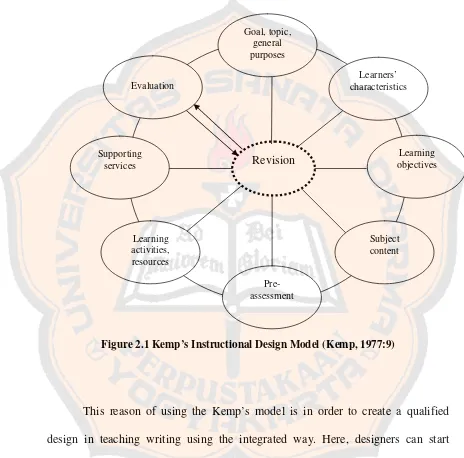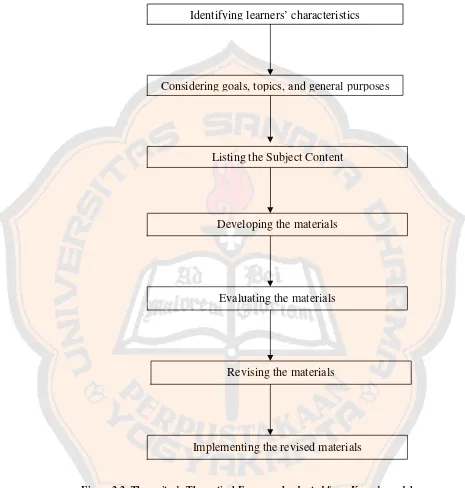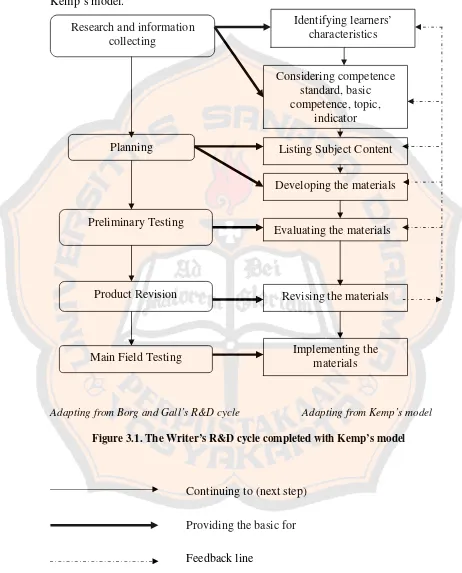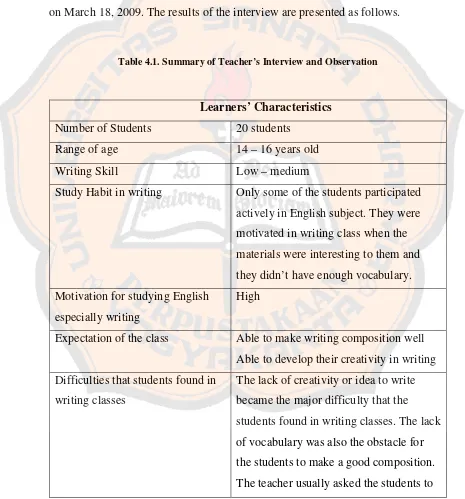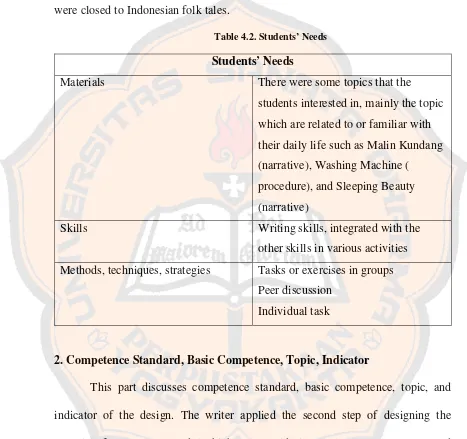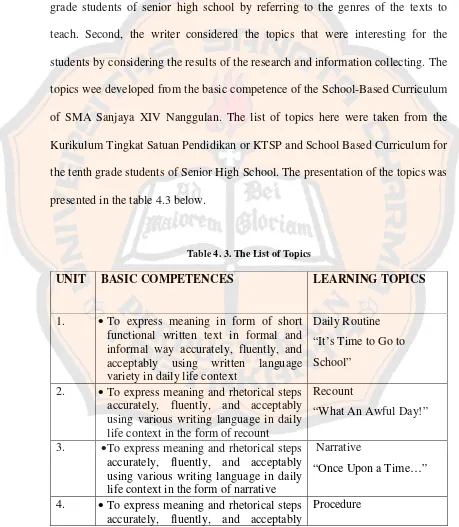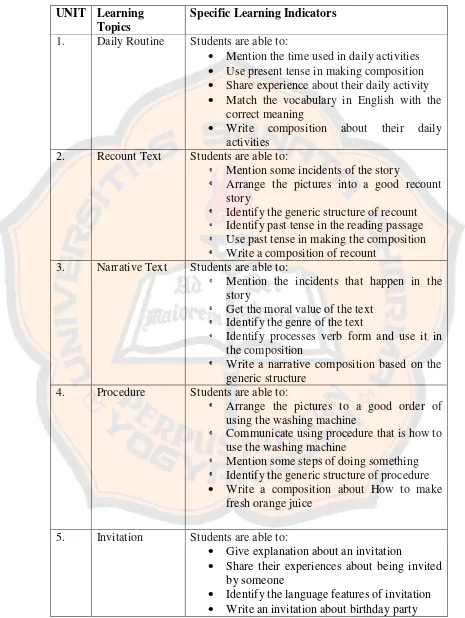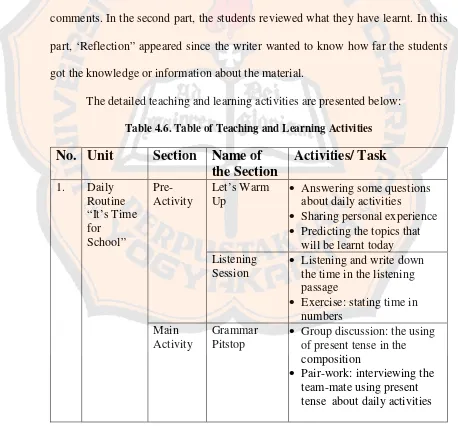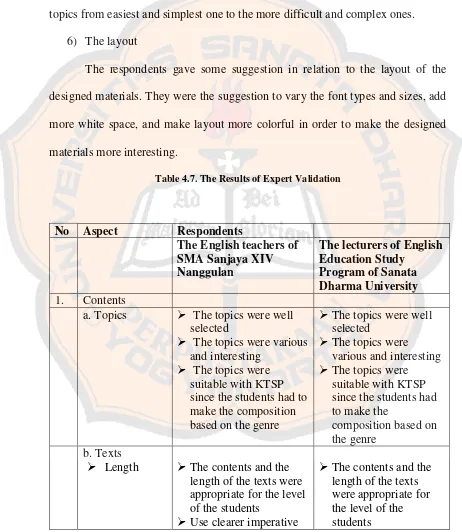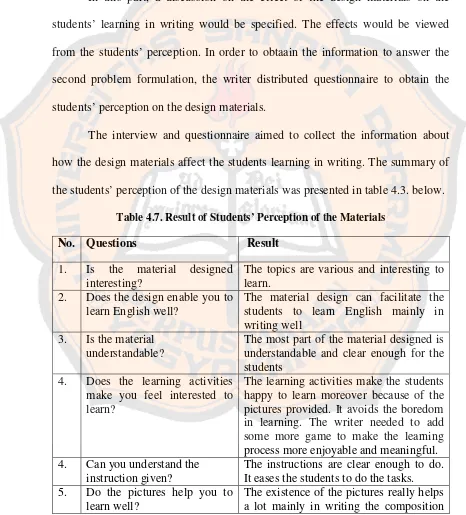DESIGNING IN
INTEGRATED WRITING ACTIVITY MA ICTURES FOR THE TENTH GRADE STUD
OFSMA SANJAYA XIV NANGGULAN
A THESIS
nted as Partial Fulfillment of the Requiremen o Obtain theSarjana PendidikanDegree
in English Language Education
By
Yosepha Rini Widiastuti Student Number: 041214015
LANGUAGE EDUCATION STUDY PROG MENT OF LANGUAGE AND ARTS EDUCA Y OF TEACHERS TRAINING AND EDUCA
i
DESIGNING INTEGRATED WRITING ACTIVITY MATERIALS USING PICTURES FOR THE TENTH GRADE STUDENTS
OFSMA SANJAYA XIV NANGGULAN
A THESIS
Presented as Partial Fulfillment of the Requirements to Obtain theSarjana PendidikanDegree
in English Language Education
By
Yosepha Rini Widiastuti Student Number: 041214015
ENGLISH LANGUAGE EDUCATION STUDY PROGRAM DEPARTMENT OF LANGUAGE AND ARTS EDUCATION FACULTY OF TEACHERS TRAINING AND EDUCATION
SANATA DHARMA UNIVERSITY YOGYAKARTA
ii A Thesis on
DESIGNING INTEGRATED WRITING ACTIVITY MATERIALS USING PICTURES FOR THE TENTH GRADE STUDENTS
OFSMA SANJAYA XIV NANGGULAN
By
Yosepha Rini Widiastuti
Student Number: 041214015
Approved by
Sponsor
iii A Thesis on
DESIGNING INTEGRATED WRITING ACTIVITY MATERIALS USING PICTURES FOR THE TENTH GRADE STUDENTS
OFSMA SANJAYA XIV NANGGULAN
By
YOSEPHA RINI WIDIASTUTI Student Number: 041214015
Defended before the Board of Examiners on 29 July 2011
and Declared Acceptable
Board of Examiners
Chairperson : C. Tutyandari, S.Pd., M.Pd. __________________
Secretary : Made Frida Yulia, S.Pd., M.Pd. __________________
Member : G. Punto Aji, S.Pd., M.Hum. __________________
Member : C. Tutyandari, S.Pd., M.Pd. __________________
Member : Made Frida Yulia, S.Pd., M.Pd. __________________
Yogyakarta, 29 July 2011
Faculty of Teachers Training and Education Sanata Dharma University
Dean,
iv
I dedicated this thesis to Jesus Christ,
my beloved family, my best friends,
v
STATEMENT OF WORK’S ORIGINALITY
I honestly declare that this thesis, which I have written, does not contain the work or parts of the work of other people, except those cited in the quotations and the references, as a scientific paper should.
Yogyakarta, 29 July 2011 The Writer
vi ABSTRACT
Widiastuti, Yosepha Rini. 2011. Designing Integrated Writing Activity Materials Using Pictures for the Tenth Grade Students of SMA Sanjaya XIV Nanggulan. Yogyakarta: Sanata Dharma University
Pictures as a useful medium to teach integrated writing activity materials for the tenth grade students of senior high school can be used to help them in making composition. Moreover, pictures can help the students to express their idea in making composition since pictures is a good example of teaching media. The using of pictures can reduce students’ boredom in writing. By using pictures, students can develop their creativity in learning English especially speaking.
This study was aimed to help Senior High School teachers to design the integrated writing activity materials especially for the tenth grade students of SMA Sanjaya XIV Nanggulan. There were two problems of this study: 1) What is the design of integrated writing activity materials for the tenth grade students of SMA Sanjaya XIV Nanggulan and 2) What are the effect of the design to the students’ learning?
This study was done by conducting the steps’ of Kemp’s instructional design model which was put under the umbrella of Borg and Gall’s R&D cycle. This study also considered relevant theories related to integrated learning, writing, pictures, and Communicative Learning.
This study has found the answers to the formulated problems above. First, the integrated writing activity materials using pictures for the tenth grade students of SMA Sanjaya XIV is the design which includes the identification of learners’ characteristics and needs, fulfill one competence standard and two basic competences which are stated in the Kurikulum Tingkat Satuan Pendidikan (KTSP).
vii ABSTRAK
Widiastuti, Yosepha Rini. 2011. Designing Integrated Writing Activity Materials Using Pictures for the tenth Grade Students of SMA Sanjaya XIV Nanggulan. Yogyakarta: Universitas Sanata Dharma
Gambar sebagai media yang sangat berguna untuk mengajar menulis yang terintegrasi untuk kelas sepuluh sekolah menengah atas dapat digunakan untuk membaantu siswa membuat karangan. Terlebih lagi, gambar dapat membantu siswa mengekspresikan ide-ide mereka dalam membuat karangan karena gambar adalah media yang baik untuk pembelajaran. Penggunaan gambar dapat mengurangi kebosanan siswa dalam menulis. Dengan menggunakan gambar, siswa dapat mengembangkan kreatuvitas mereka dalam belajar bahasa inggris terutama menulis. Kegiatan yang terintegrasi dipilih karena membuat siswa mengetahui hubungan antar skill, dan menyediakan fleksibilitas yang besar untuk guru dalam menciptakan pelajaran yang menarik dan memotivasi.
Studi ini bertujuan untuk membantu para guru di sekolah untuk mendesain materi menulis yang terintegrasi terutama untuk siswa kelas sepuluh di SMA Sanjaya XIV Nanggulan. Terdapat dua permasalahan untuk dipecahkan dalam studi ini yaitu: 1) Seperti apa desain materi menulis menggunakan gambar yang terintegrasi untuk siswa kelas sepuluh di SMA Sanjaya XIV nanggulan dan 2) Apa pengaruh materi terhadap pembelajaran siswa dalam menulis.
Studi ini diselesaikan dengan menerapkan langkah-langkah dari model desain materi Kemp yang dimasukkan dalam langkah-langkah metode penelitian dan pengembangan pendidikan (R&D) Borg dan Gall. Studi ini juga menggunakan teori-teori yang berkaitan dengan pembelajaran terintegrasi, menulis, teori tentang gambar sebagai media dan teknik, serta pembelajaran komunikatif.
Studi ini telah menemukan jawaban atas pertanyaan di atas. Pertama, desain maateri menulis yang terintegrasi dengan menggunakan gambar untuk siswa kelas sepuluh SMA Sanjaya XIV nanggulan adalah desain yang mencakup adanya identifikasi kebutuhan dan karakteristik siswa, memenuhi satu standar kompetensi dan dua kompetensi dasar dalam Kurikulum Tingkat Satuan pendidikan (KTSP). Setiap unit terdiri dari enam bagian aktivitas yang saling terintegrasi.
viii
LEMBAR PERNYATAAN PERSETUJUAN
PUBLIKASI ILMIAH UNTUK KEPENTINGAN AKADEMIS
Yang bertanda tangan di bawah ini, saya mahasiswa Universitas Sanata Dharma:
Nama : Yosepha Rini Widiastuti Nomor Mahasiswa : 041214015
Demi pengembangan ilmu pengetahuan, saya memberikan kepada Perpustakaan Universitas Sanata Dharma karya ilmiah saya yang berjudul:
DESIGNING INTEGRATED WRITING ACTIVITY MATERIALS USING PICTURES FOR THE TENTH GRADE STUDENTS
OF SMA SANJAYA XIV NANGGULAN
beserta perangkat yang diperlukan (bila ada). Dengan demikian saya memberikan kepada perpustakaan Universitas Sanata Dharma hak untuk menyimpan, mengalihkan dalam bentuk lain, mengelolanya dalam bentuk pangkalan data, mendistribusikan secara terbatas, dan mempublikasikannya di internet atau media lain untuk kepentingan akademis tanpa perlu meminta ijin dari saya maupun memberikan royalti kepada saya selama tetap mencantumkan nama saya sebagai penulis.
Demikian pernyataan ini saya buat dengan sebenarnya.
Dibuat di Yogyakarta
Pada tanggal: 29 Juli 2011
Yang menyatakan
ix
ACKNOWLEDGEMENTS
First of all, I would like to thank Jesus Christ for His endless blessing. My admiration is addressed for the strength He granted to me to accomplish my
study at Sanata Dharma University.
Next, I would like to address my greatest gratitude to my inspiring parents,
Yohanes Sudarmono Hadi and Anastasia Hartiah, for their endless support, care and love in my life. For my beloved brother and sister, Floribertus Septa Ibnu and Wian Apriyani Dewi, thank you for your everlasting support in everything I do. For my true friend,Nitasari, thank you for always being there for me, for the friendship, and for all the precious things I owe that cannot be
measured by anything.
I am deeply grateful to my thesis sponsor, G. Punto Aji, S.Pd., M.Hum. for his willingness to share his knowledge and expertise. I thank him for his
guidance, criticism, advice, support, and encouragement in helping me write this
thesis.
I would like to thank Maria Antonia, S.Pd. as the English Teacher of SMA Sanjaya XIV Nanggulan. I thank her her for giving me a lot of information
in my thesis and for her willingness in helping me during the process of my
research. My deep gratitude alo goes toDrs. Gunawan, M.A.as the participant of materials evaluation. I really thank him for the feedback, suggestions, and
x
I would like to thank PBI teaching staff for educating me during my
college years. For Mbak Tari and Mbak Danik, thank you for the amazing assistance, for the service and psatience during my study.
I wish to thank all my beloved friends in PBI 2004 especially Patricia Angelina, Cahyarini, Arsita Nindya, Anggraeni Suryana, Vina Andriani, Dian Himawatiand Brigitta Riri for their support, care, and the encouragement they always gave me. My special gratitude goes toElly, Risa, Nora, Putri, Anna, Leony, Tami, Retno, Jati, Tika, Bekti, Indri, Polly, Endhi, Beni, Nia and Dewatifor giving me happiness, support and care during my time in finishing my thesis. For all my friends in Happy Bear, especiallyNancy Sukmawati, thank you for the support and for all the things we shared together.
Finally, my deepest thank goes to everybody who has helped me, either
directly or indirectly, in writing this thesis.
xi
TABLE OF CONTENTS
Page
TITLE PAGE... i
APPROVAL PAGES ... ii
DEDICATION PAGE ……….. iv
STATEMENT OF WORK’S ORIGINALITY ...…. v
ABSTRACT ...……… vi
ABSTRAK... …….. vii
PUBLICATION PAGE ...……… viii
ACKNOWLEDGEMENTS ...……… ix
TABLE OF CONTENTS ...…. xi
LIST OF TABLES ...……… xv
LIST OF FIGURES ...…… xvi
LIST OF APPENDICES ...……… xvii
CHAPTER I: INTRODUCTION ... 1
A. Research Background ... …….. 1
B. Problem Formulation ………. 4
C. Problem Limitation ………... 4
D. Research Objective ………. 4
E. Reserach Benefit ……….. 5
xii
CHAPTER II: THEORETICAL REVIEW... 8
A. Theoretical Description ... ……… 8
1. Kemp’s Instructional Model Design ………. 8
2. Syllabus Design ………. 12
3. Pictures ………... 14
a. Definition of Pictures ………... 14
b. Characteristics of Good Pictures ... 15
c. The Use of Pictures ... 15
4. Theory of Writing ... 17
a. The Nature of Writing ………... 17
b. The Principle for Teaching Writing ……….. 17
c. Writing Process ……… 19
d. The Teaching of Writing ……….. 21
5. Integrated Materials……… 24
6. The Characteristics of the Students ………. 25
B. Theoretical Framework ……… 26
CHAPTER III: METHODOLOGY ... 30
A. Research Method ……… 30
1. Research and Information Collecting ……… 31
2. Planning ... ……….... 31
3. Preliminary Field Testing ………... 32
xiii
5. Field Testing……… 32
B. Research Participant ……….. 34
1. Partcipants for Conducting Research and Information Collecting……….. 34
2. Participants for Conducting Preliminary Field Testing .... ……… 34
3. Participants for Main Field Testing ……….… 35
C. Research Instrumen ………. 35
1. Reserach Instrument for Research and Information Gathering … 35 2. Research Instrument for Preliminary Field Testing ………. 36
3. Research Insstrument for Main Field Testing……… 36
D. Data Gathering Techniques ……….. 36
E. Data Analysis Techniques ……… 37
F. Research Procedure ……….. 38
CHAPTER IV: RESEARCH FINDINGS AND DISCUSSIONS... 40
A. The Design of Integrated Writing Activity Materials Using Pictures for the Tenth Grade Students of SMA Sanjaya XIV Nanggulan ... 40
1. Learners’ Characteristics ……….. 41
2. Competence Standard, Basic Competence, Topics, and Indicators 44 3. Subject Content ………. 48
4. The Material Design ………. 49
5. Feedback from the Product Validation ………. 57
xiv
B. The Effects of the Materials to the Students’ Leraning ... 63
1. Description of the Field Testing………. 63
2. Discussion on the Effects of the Materials ... 66
CHAPTER V: CONCLUSIONS AND SUGGESTIONS ... 68
A. Conclusions ………... 68
B. Suggestions ………... 69
REFERENCES………. 71
xv
LIST OF TABLES
Table Page
4.1 Summary of Teacher’s Interview and Observation ……… 43
4.2 The Students’ Needs……… 44
4.3 The List of Topics……….. 45
4.4 Table of Learning Indicators……….. 47
4.5 Table of Subject Content ……… 48
4.6 Table of Teaching and Learning Activities………. 54
4.7 The Result of Expert Validation……….. 59
xvi
LIST OF FIGURES
Figure Page
2.1 Kemp’s Instructional Design Model ……….. 11
2.2 The Writer’s Theoretical Framework Adapted from Kemp’s Model……. 29
xvii
LIST OF APPENDICES
Appendix Page
Appendix 1: Letter of Permission ……… 73
Appendix 2: List of Questions for Needs Analysis Interview ……….. 74
Appendix 3: Result of Needs Analysis Interview ……….. 76
Appendix 4: Questionnaire ……… 78
Appendix 5: List of Questions for Design Validation Interview ………….. 79
Appendix 6: Result of Product Validation Interview ……… 81
Appendix 7: Questionnaire for Main Field Testing ……….. 83
1 CHAPTER I INTRODUCTION
This research intends to propose integrated writing materials using pictures
for the tenth grade students of SMA Sanjaya XIV Nanggulan. Chapter I discusses
(A) the background of the problem, (B) the problem formulation, (C) the problem
limitation, (D) the research objective, (E) the research benefits, and (F) the
definition of the terms.
A. Background of the Study
As stated in the newest curriculum, Curriculum at the School Level
(KTSP), one of the language skills that have to be mastered by the students in
Senior High School is writing skill. There are some kinds of composition in
writing for the third grade students such as descriptive, narrative, spoof, recount
and exposition. In this new curriculum, students are expected not only to be able
to produce a good composition but also to create the composition based on the
guideline of the arrangement of each type. Writing is one of the four skills that
need to be taught by teacher instead of speaking, listening and reading.
Those English skills are related with one another. It means that in the
language teaching, the four skills cannot be totally separated from one another. In
fact, many English teachers just emphasize the learning process of the target
biggest consideration is because writing is not applied on the National
examination (UAN) for the UAN only uses multiple choices as the question form.
Writing skill requires students’ creativity, imagination and critical thinking
in order to produce a high-qualified composition. This process requires active
thinking. That is to say, a student must know his purpose, think about the fact that
he will select, and think about how to organize the facts in a coherent function.
Unfortunately, they are still confused in organizing their idea into good
composition even when they use their first language or in this case is Indonesian
language. The question emerges in how the students can arrange good
composition using English where there will be more difficulties in using it in
writing.
The writer has chosen one of Senior High School in Kulon Progo namely
SMA Sanjaya XIV Nanggulan as the research area. The tenth grade students
became the research participants in this study. The writer chose this level because
it is the level where writing is taught as one of the English skill. In this level, the
students focus on various kind of text types such as narrative, daily routine,
recount, and procedure.
The reality in SMA Sanjaya shows that most of the tenth grade students
always feel confused and frustrated if they are asked to make composition in
writing class. Ironically, the English teachers just teach them in conventional way
without any effort to develop the students’ creativity to write through effective
learning. It is so dilemmatic because in the KTSP curriculum, students are
In short, students need interesting and challenging material to help them
explore their potential in writing. As far as the writer knows, most material in
writing is mainly in the form of written theory. It can cause low motivation of
students in learning because they feel bored moreover because Senior High school
students seem to have low enthusiasm in reading such theory. They need guidance
to write the composition well. According to Hill (1980:20), picture is an excellent
material for guiding composition since the language content can be kept simple. It
will be more perfect if it is combined with the presence of other skills in one
integrated material. The students will focus on writing without neglecting the
other skills such as listening, reading and speaking through meaningful activity
and possibly games in one learning activity.
Pictures are often used by teachers to facilitate learning in various
activities. The advantage of pictures is students will immediately foster the use of
common vocabulary items and common language forms (Raimees, 1983; 27-28).
Pictures stimulate the students to practice the language skills and elements and
make the learning enjoyable.
Tenth grade is the first grade in Senior High School. Some students may
have learned English in the previous grade that they have enough vocabulary. It
becomes the main reason to present the integrative materials that are suitable to
the students’ level and competence. The study is intended to propose a set of
integrated material in writing to the tenth grade of Senior High School students
based on the reason that most of previous theses in writing just combine the way
study the integrated material, there are seldom of the theses that try to use the
integrated material to teach writing for their students. It is hoped that this thesis
will give new innovation in teaching the skill.
B. Problem Formulation
There are two questions which become the basis for this research. The
questions are:
1. What is the design of Integrated Writing Activity Materials Using Pictures
for the Tenth Grade Students of SMA Sanjaya XIV Nanggulan?
2. How do the designed materials affect the students’ learning in writing?
C. Problem Limitation
The research is limited to the discussion on designing a set of integrated
material using two-dimensional pictures stories in teaching writing for the tenth
grade students of SMA Sanjaya XIV Nanggulan. The designed integrated
materials will present the writing skill using two-dimensional pictures stories to
guide the students in producing good composition using the genres taught in the
tenth grade of senior high school.
D. Research Objectives
This research is conducted in order to:
1. Design the integrated material in teaching writing for the tenth grade
2. Find the effects/impacts from the implementation of the materials to the
students’ learning in writing
E. Research Benefits
This research is conducted to give some benefits to the teaching writing in
Senior High School especially to the tenth grade students of SMU Sanjaya XIV
Nanggulan, Kulon Progo. The benefits of this research can be clarified as stated
below.
1. For English Teachers
Since some English teachers have difficulties in presenting suitable
material for students, the result of this research is expected to help them provide
the materials in the writing class. The integrated material using pictures is hoped
to be useful for teachers to help students to increase their writing skill through
various activities.
2. For the tenth grade students of SMA Sanjaya XIV Nanggulan
The well-developed English integrated material using pictures are
provided for the tenth grade students of Senior High school students to improve
their ability in writing. It is hoped that students can enjoy the class through the
presented material.
3. For the writer
Because the writer will be an English teacher, the result of this study is
pictures in teaching writing. The material is hoped can be applied in her job as
an English teacher later to improve the students’ ability in writing.
G. Definition of Terms
There are some terms used in this study that need to be clarified. These
terms are:
1. Instructional Material Design
Instructional Material Design is systematic proceeds for designing,
developing, implementing, and evaluating instruction (Kemp, 1977: 8). In this
study, the term instructional design is understood as a process to design the
integrated material using pictures in teaching writing for the first grade students of
Senior High School. It is done in order to set the content of instruction.
2. Pictures
Duffy nd Waller (1989;249) define pictures as some hand-made or
machine-made image that relates, however distantly, to the appearance or
structure of reaal or imagined thing. In this stuy, pictures are used as valuable
media in teaching resources. Pictures can be in form of flashcards, large wall
pictures, cue cards, photographs or illustrations.
3.Writing
Tiedt (1987:7) perceives writing as one way of expressing thinking a
performance process. The process of writing is a total learning experience that
includes what happens after the students write (post-writing). During the process,
4. Integrated material
According to Harmer (1976), Integrated material in English teaching is the
material which is consisted of language skill exercises and elements; it is possible
to include games in the material. It contains listening, speaking, reading, writing
and also vocabulary in the presented material. In this study, the writer will
combine the four skill activity which focus is on writing.
5. SMA Sanjaya XIV Nanggulan
In Indonesia, SMA stands for Sekolah Menengah Atas. It refers to the so
called senior high school. There are three levels in it named tenth grade, eleventh
grade and twelvth grade. SMA uses semester system. The learners in this study
are from the tenth grade students in SMA Sanjaya XIV Nanggulan, Kulon Progo,
8 CHAPTER II
THEORETICAL REVIEW
In the theoretical review, (A) theoretical description and (B) theoretical
framework will be discussed. Here, the writer will write theoretical description first
and then theoretical framework.
A. Theoretical Description
In this part, the theories of discussion support several steps to make the
framework of designed models. The first is about Instructional Design Models, the
second is about pictures, the third is about the nature of writing, the fourth is about
the integrated material the last is about the learners’ characteristics.
1. Instructional Design Models
Instructional Design is the systematic process of translating general
principles of learning and instruction into plans for instructional materials and
learning approach and procedure that can be applied (Smith and Ragan, 1993).
There is one model to be discussed in this part. The models are adopted from
Kemp’s model.
a. Kemp’s model
There should be a procedure when teachers or designers are designing
materials for the learners. In this study, the writer would consider Kemp’s
instructional design model to design and develop the authentic listening materials.
adjustment and improvement. “System approach is the overall plan of the
instructional design compiled in order” (Kemp, 1977). Kemp’s model of
instructional design is a flexible one. The designer can start from any steps as long
as the whole elements are done.
Kemp (1977:8-9) states that the designer should consider three elements
that are objectives, activities and resources, and evaluation as the basic of creating
an instructional design. If one of them is missing, then the designer fails to make a
good design. The Kemp’s model consists of eight parts.
1. Goals, Topics and General Purposes
Instructional design planning starts with a recognition of the broad goals of
the school system or institution. Within curriculum areas or courses, topics are
chosen for study, for each of which the teacher explicitly expresses the general
purposes or what students generally are expected to learn as a result of instruction.
2. Learner Characteristics
To serve both group and individual means that we must obtain information
about the learners’ capabilities, needs and interest. It aims to provide appropriate or
suitable design.
3. Learning Objectives
Writing objectives in a developmental activity that requires refinements,
changes and additions as the writer develops subsequent planning steps. To engage
actively in the learning activities, the learners need to know and understand the
learning objectives of the learning process. Objectives for learning can be grouped
4. Subject Content
A student’s learning experiences must involve subject content. The subject
content must closely relate to the objectives and to the student’s needs. Subject
content means the material consists of spesific knowledge (facts and information),
skills (step-by-step procedures, conditions, and requirements), and topics (Kemp,
1997:44)
5. Pre- assessment
Pre- assessment gives information about what extent each student has
acquired the necessary prerequisites for studying the topic and what the student
may have already mastered about the subject to be studied.
6 Teaching or Learning Activities and Resources
It is important to determine the most efficient methods and then select
materials to provide learning experiences that will utilize the content associated
with each objective. The terms most efficient and most effective are often used in
education to describe what should be done.
7. Support Service
These services include funds, facilities, equipment, and personnel whose
time must be scheduled for participation in the instructional plan. The necessary
services must be provided like certain equipment, a particular room, a sum of
money or specific technical assistance.
8. Evaluation
This is the payoff step in the instructional design- plan for both the students
The model of Kemp’s instructional design model can be seen in figure 2.1
below.
Figure 2.1 Kemp’s Instructional Design Model (Kemp, 1977:9)
This reason of using the Kemp’s model is in order to create a qualified
design in teaching writing using the integrated way. Here, designers can start
developing the instruction from every point and go anywhere, as long as the
elements are done, Kemp (1977: 9). There is interdependence among the eight
elements. The teacher will use the pictures as a helping media to explore the
students’ creativity to make their own composition. Revision
Goal, topic, general purposes
Learners’ characteristics Evaluation
Supporting services
Learning activities, resources
Pre-assessment
Subject content
2. Syllabus Design
Syllabus is designed as a document, which says what will (or what should)
be learnt, according to Hutchinson and Waters (1987: 80).The education system of
Indonesia now use Kurikulum Tingkat Satuan Pendidikan (KTSP) which proposes
some components which should be included in a syllabus. The components are:
a. Identification of the name of the school, subject, class/grade
b. Standard competence, that is the basic skills that should be learning
c. Basic competence, that is the expected performance after the students
experience the learning processing a certain competence
d. Indicators, specific form of basic competence which are measurable
e. Time allocation
f. Assessment of the students achievements
g. Sources, including books, brochures, magazines, newspapers, or internet.
According to Robinson, (1991: 34-35), syllabus is a plan of work used
by a teacher as a guideline for teaching content. Besides, a syllabus gives the
teacher idea of what the course will be and to what direction it should be brought
and done. So syllabus is very important for the teacher in designing an instruction.
There are there types of syllabus according to Robinson (1991: 35-40), namely:
1) Content based syllabus
Content based syllabus has a purpose to teach some contents using the
language that the learners are also learning. This syllabus consists of:
a) Structural syllabus, consisting of an ordered set of language items graded by
b) National/functional syllabus is a syllabus is which the content language
teaching is a collection of the function that is performed when language is
used.
c) Situational/contextual focus syllabus is a syllabus in which situational
becomes the basis of activities.
d) Topic/information syllabus, consisting o-f some topics relevant to the learners
or to activities.
2) Skill based syllabus
Skill based syllabus is a syllabus is which the contents of the language
teaching was a collation of specific abilities that may play a part in using
language. There are two kinds of skill based:
a) Based on language skills. It is divides into four skills, namely, productive
speaking, writing and perceptive reading and listening.
b) Based on learning skills. It is looking at the constituents of the language skills
that area sub skills and micro skill.
3) Method based syllabus
Method syllabus is divided into two sub categories as clarified below:
a) Process syllabus. This character refers to procedure of method of language
learning.
b) Task syllabus. This type of syllabus consists of a set of tasks ordered
according to cognitive difficulty.
This study uses functional syllabus since the learners need to learn how to
provide the learners “a route map” of the course. In the same time, it will be the
teacher’s guidelines to design the lesson that will be taught to the tenth grade
students of SMA Sanjaya XIV Nanggulan.
3. Pictures
Pictures are often used by teachers to facilitate learning. Pictures can be in
form of flashcards, large wall pictures, cue cards, photographs or illustrations.
Pictures are really useful to use in language learning because pictures not only
stimulate students to practice the language skills but also making the learning
activity enjoyable. The pictures need to be appropriate not only for purpose in hand
but also for classes they are being used for. This section discusses the definition of
pictures, the characteristics of good pictures, and the using of pictures in this
design.
a. Definition of Pictures
Duffy and Waller define pictures as some hand-made or machine-made
image that relates, however distantly, to the appearance or structure of real or
imagined things (1989:249). Pictures represent real or imagined situations or
things. So, according to Rames (27-28), a picture is a valuable media in teaching
resource as it provides those criteria:
1. a shared experience in the classroom;
2. a need for common language forms to use in the classroom
3. a variety of tasks
b. Characteristics of Good Pictures
Hamalik states that there are five criteria to define whether a picture is good
or not (1989:67-68). Good pictures should:
1. Depict the real situation or condition
2. Simple in color, impressive, aesthetic and practical
3. Familiar
4. Show activities
5. Artistic
The choosing of pictures for teaching writing skill in this research will follow
those criteria above.
c. The using of pictures
Pictures can be used in any kind of activities mainly in teaching English
(Harmer: 1976). Here are six activities that can be used using pictures such are
drills, (communication) games, understanding, ornamentation, prediction, and
discussion.
1. Drills
In this session, flashcards are often used for drilling grammar items, for cueing
different sentences, or practicing vocabulary. It is intended mostly to lower-level
students to train the response.
2. (Communication) games
Pictures are extremely useful for a variety of communication activities, such as
they have to work out what story the pictures together are telling. Teachers
sometimes use pictures for creative writing. For example, they have a conversation,
and they have to pick at least three cards during it.
3. Understanding
One of the most appropriate uses for pictures is for the presenting and checking of
meaning. In the same way it is easy to check students’ understanding of a piece of
writing or listening by asking them to select the picture.
4. Ornamentation
Pictures of various kinds are often used to make work more appealing. It is because
that picture enhances the text, giving readers a view of the outside world. Pictures
have the power to engage students’ interest.
5. Discussion
Pictures can stimulate questions to students. Teacher may ask student to describe,
invent the conversation, set a role-play activity, and even answer questions.
6. Prediction
Pictures are useful for getting students to predict what is coming next in a lesson.
This use of pictures is very powerful and has the advantage of engaging students in
the task to follow.
In students writing activity through integrated material, the pictures are
used as a media to help students to brainstorm their idea and later to help them
arrange a good composition. Students will compose the writing with their own
words by using the story presented by the pictures. This activity will be used in
There is a double advantage here: the teacher is relieved of the task of
finding a picture and the students have something that has personal meaning for
them to answer questions about and write about in the classroom.
4. Theory of Writing
Students has to master writing as one of the important language skill.
Writing requires students’ experience, creativity, and logical think to produce a
good composition. This part will state the definition of writing, the benefits of
writing, general principles for teaching writing, and the teaching of writing.
1. The nature of writing
Weisman (1990:10) states that writing is a method of expressing ideas
about any subject content in written form. It is a holistic process in a language.
Using English according to the convenient is established by educated uses of the
language and adapting it to the circumstances in which we use it will not make us
effective speakers and writers (Warner, 1982:82). If the students use the right
Standard English, people will judge them as good learners. The usage of good
written writing will be judged good too by others.
2. The Principle for Teaching Writing
According to Carrier (1981:6), there are three main principles for teaching
writing:
1. Develop students’ competence in the use of specific functions of language such
2. Develop students’ understanding of the differences between written and spoken
English form
3. Develop and practice specific writing skills such as composing a letter,
summarizing and writing report.
Meanwhile according to Kroll (2001), the principles of teaching writing are
stated below:
1. Understand your students’ reasons for writing
It is important to match the teacher’s goal with the student’s goal of writing,
in this case is the goal of writing which is stated in the Kurikulum Tingkat Satuan
Pendidikan or KTSP. It is important to understand both and convey goals to
students in ways that make sense to them.
2. Provide many opportunities for students to write
Writing almost always improves with practice. The teacher has to think
about how much time is spent actually for writing with the combination of the
other skills such as listening, speaking, and reading. Practice writing should
provide students with different types of writing as well. When practice writing
sessions are integrated regularly into the syllabus, students will become more
comfortable with the act of writing.
3. Make feedback helpful and meaningful
Teacher needs to make sure that the students understand the vocabulary or
symbols used because students crave feedback on their writing especially in
In order to foster independent writers, teacher can provide summary comments that
instruct students to look for problems and correct them on their own.
4. Clarify for the teacher, and for the students, how the students’ writing will be
evaluated
The teacher needs class time to ask the students about what they value in
writing, what features make writing enjoyable to read and what features distract
from that enjoyment. It will give the students a voice of evaluation of their own
work and it also provides a common vocabulary with which the entire class can
discuss their writing and the writing of others.
3. Writing process
The writing process needs activities that encourage the idea that learning to
write is more than creating a final product; it is the learning of a series of skills
leading to that product (Kroll: 96-97). The activities are stated and explained as
below:
1. Brainstorming
Brainstorming can be done individually or in pairs of group of students. In a
brainstorming session, students list all the ideas they can think of related to a topic
quickly and without much planning. Students need to be given plenty of time for
this activity.
2. Wordmapping
Wordmapping is more visual than brainstorming. When students create
wordmaps, they begin with related ideas or words and draw relationships with a
3. Quickwriting
In this section, students write rapidly about a topic. The time limitation is
needed here for about 10 or 15 minutes. Students are given instruction to keep
writing without stopping, and just let the ideas and words come out without
concern for spelling, grammar, or punctuation.
4. Writing
This is the time for the students to write the first draft. They need to focus
on the development of ideas and the organization of those ideas more than the
development of perfect grammar, punctuation or spelling.
5. Proofreading and editing
Before the final draft is turned in for evaluation, students should read for
mistakes in grammar, spelling, punctuation and so forth. In developing independent
writers, it is important that students learn to proofread and edit their own as much
as possible although the pair work is also needed.
In applying the writing process, any of these steps can and should be
performed at any stage although these techniques are presented in a linear
fashioned as mentioned above. One of the disadvantages of doing the whole
process writing is that it takes time. However, the various stage may involve
discussion, research, language study, and a considerable amount of interaction
between teacher and students and between the student themselves so that when
process writing is handled appropriately it stretches across the curriculum
4. The Teaching of Writing
In any sequence of tasks, listening, speaking, reading, and writing are best
integrated. In teaching writing in integrated way, there are three kinds of teaching
for a teacher to do it. There are modeling, joint-construction, and independent
writing.
1. Modeling
Modeling in writing intends to enable students to plan, write, and redraft
with confidence, having gained a knowledge and understanding of text types,
purpose and, and audience (www.tki.org.nz). It is useful to enhance confidence and
develop skills through shared activity, where it is safe to take risks and make
mistakes. In the teaching of the classroom, it is suitable to dig students’
understanding about different types of writing like narrative, procedure, and
recount.
Modeling needs the making of features of a text type explicit by planning,
deconstructing, analyzing, composing, or redrafting at word, sentence, and whole
text level. The existence of pictures will enable the students to develop their ability
in writing various types of writing.
2. Joint-Construction
Joint-Construction is a collaborative teaching process involving the students
and the teacher in constructing a text, individually, in small groups, and as a whole
class. It is an effective tool in teaching students about the processes of writing,
forms of writing, the conventions, skills and behavior of writing
Joint-construction process supports ongoing monitoring and assessment of
students’ writing processes and use of specific strategies. The patterns varied to the
students’ self-selected revision goals, which were related to their level of target
language proficiency, the choice of discourse topic, and the teachers underlying
pedagogical goals.
3. Independent Writing
In independent writing, students are expected to build their own repertoires
of strategies and they learn to approach learning tasks in a strategic way. They
write their own pieces (www.oe.k12.mi.us). In KTSP, these pieces could include
stories and informational narratives. Independent writing provides a change for
children to use writing across the curriculum. It builds children’s ability to write
words and use punctuation.
Ideas for independent writing come out of group sessions. The teacher
should help students learn the strategies and skills for independent writing. Teacher
support is needed because children write using known words and construct the
spelling of unknown words. It is important that children know how to use the
resources in the room to get the words they do not know. Pictures are useful to help
them develop their vocabulary of English and to raise students’ awareness of the
materials especially in making composition.
The teaching of writing will be combined with the other skills such as
listening, speaking, and reading in one learning activity. Here, the writing activity
will be used as the main activity and the core of the designed materials in one
6. Methods Used in This Design
There are two kinds of methods that can be used in teaching writing. Those
two methods are the Communicative Language Teaching (CLT) and Direct Method
(DM).
1. Direct method
This method intends that students learn how to communication in the target
language. Students are forced to learn to think in the target language. The work on
all four skills (reading, writing, speaking, and listening) occurs from the start, oral
communication is seen as basic. Thus the reading and writing exercises are based
upon what students practice orally first (Larssen-Freeman, 2000:30).
Teachers who use direct method believe that students need to associate
meaning and the target language directly. In order to do this, when the teacher
introduces a new target language word or phrase, he demonstrates its meaning
through the use of realia, pictures, or pantomime. Grammar is taught inductively,
the students are presented the examples and they figure out the rule or
generalization from the examples. In direct method, students are to demonstrate
their knowledge about the language using both oral and written skills. For example,
students are interview by the teacher or asked to write a paragraph about something
they have studied.
2. Communicative Language Method
Communicative Language teaching aims broadly to apply the theoretical
perspective of the Communicative Approach by making communicative
interdependence of communication. The goal is to enable students to communicate
in the target language. Students work on all four skills from the beginning. Here,
communication is the main emphasize in the study.
5. Integrated Material
Integrated approaches in language teaching means approaches that
encourage the teaching of four skills within the general framework of using
language for learning as well as communication. It gets students to perceive the
relationship among several skills, and provides the teacher with a great dela of
flexibility in creating interesting and motivating lessons (Harmer; 1976). The
integration of the four skills is the typical pproach within a communicative,
interactive framework. There are three forms of integrated skill instruction
(Harmer;1976):
a. Task-Based Instruction
In task-based instruction, students participate in communication tasks in
English. It requires comprehending, producing, manipulating, or interacting in
authentic language (Nunan, 1989). In task-based instruction, basic pair-work and
group-work are often used to increase students’ interaction and collaboration.
b. Content-Based Instruction
This design will use theme-based models because it must be very
interesting and it always a wide variety of language skills to be practiced
(Scarcella&Oxford, 1992). The emphasis will be put on writing and to ease the
language skills in a highly integrated, communicative fashion while learning
content. It is valuable at all levels of proficiency.
c. Theme-Based Instruction
Theme-based units a common idea to pull together student learning while
focusing on many ways that students learn. It uses different learning styles and
multiple intelligences to help students access and retain new knowledge. It
provides meaningful topics and methods assists in generalizataions of skills and
knowledge to everyday life.
6. The Characteristics of the Learners
In this study, the learners mean the tenth grade students of Senior High
School. The students have some important characteristics which need to be
considered in des he students’ range of age is around 14 up 16 years old. It shows
that they are mature enough in learning the appropriate material, in this case is the
integrated material using pictures. They have experience in learning a foreign
language especially English. They also have enough attention and are able to
understand the material input from their teacher.
They have some basic understanding of English as a foreign language since
English are taught from the first grade of Junior High School. Logically, English is
not an unfamiliar subject because they have learnt about it for about 3 years or
more since English is taught as a compulsory subject in Senior High School. In the
school can be categorized as intermediate learners. They have enough language
awareness to help them studying English as a foreign language.
The tenth grade students of senior high school have also external motivation
in studying English because English is one of three main subjects which will be
held in the National Examination or Ujian Akhir Nasional (UAN). They need to
pass the examination in order to continue their study in the higher educational
school.
B. Theoretical Framework
In designing a set of integrated material using pictures in teaching writing
to the tenth grade students of senior high school, the Kemp’s model of the material
design discussed in the Theoretical Description are used. Those models are
modified to make a framework or guideline to construct the materials.
In the integrated material which involve four language skills, the activities
which use pictures are placed in whilst activity. The activity itself will contain of
three main activities: pre-activity, whilst activity, and post-activity. A series of
pictures will be emphasized as the main activity for students. The complete steps
conducted in this design are:
1. Identifying Learner’s Characteristic
Before making the design, the writer will do a survey study to find out the
students’ needs in learning English especially in writing. It is done by interviewing
some English teachers and by distributing open questionnaires to one class of tenth
2. Considering Goals, Topic, and General Purposes
In this study, the term goal means the competency standard stated in the
KTSP which the students have to achieve it in their learning. The basic competence
of the design is to enable and reinforce students to produce qualified writing
through the provided media that is writing.
3. Listing the Subject Contents
The content function is to facilitate the achievement of each objective. The
subject content mostly will be based on the integrated material and the theory of
writing. Integrated material using pictures will enable the students to explore their
ability in writing.
4. Developing and Designing the Materials
Next, the writer developed the integrated writing activity materials based on
the students’ needs, lacks, weaknesses, and interests. The writer developed three
units of seven units.
5. Evaluating and Revising the Designed Material
According to Kemp’s instructional design model, some revisions were
needed to improve the designed materials. In this step, the writer revised the
designed materials based on the respondents’ suggestions and criticism obtained
from the evaluation step. It should also be noted that the revisions can actually
occur in every step so that the writer could monitor the design and confirm whether
the design is already appropriate or not. The writer asked for the suggestion from
the lecture of English Education Study Program of Sanata Dhrama University and
6. Revising the Materials
The writer conducted the revision based on the evaluation from the experts.
After that, the writer prepared to implement the product in a real classroom of tenth
grade students at SMA Sanjaya XIV Nanggulan, Kulon Progo.
7. Implementing the revised materials
In this step, the writer applied the product that had been revised by the
experts. The writer applied the theory of writing in implementing the materials to
introduce the text types through the target lanaguage. The theory of communicative
writing was also applied in the implementation of the materials to allow the
students to communicate with. The writer then distributted questionnaire to obtain
students’ opinion on the designed materials.
Figure 2.2: The writer’s Theoretical Framework adapted from Kemp’s model Identifying learners’ characteristics
Considering goals, topics, and general purposes
Listing the Subject Content
Developing the materials
Evaluating the materials
Revising the materials
30 CHAPTER III METHODOLOGY
This chapter presents some important points which refer to the method
used to answer the questions stated in the problem formulation. Chapter III
discusses (A) research method, (B) research subject, (C) research instruments, (D)
data gathering, (E) data analysis and (F) procedure of the research.
A. Research Method
There are two problems in this study which needed to be solved; they are
what the design of integrated writing activity materials using pictures for the tenth
grade students of SMA Sanjaya XIV Nanggulan is and how the materials affect
the students learning in writing. In order to answer the two problems above, the
writer will use a method which was called Educational Research and
Development (R&D). According to Borg (1983), R&D is a process used to
develop and validate educational products.
In applying this method, the writer conducted some interviews, classroom
observations, and distributed questionnaire to the relevant participants. Those
activities were done to obtain some findings which would be used as the main
considerations for the writer to design the materials.
Each step is elaborated on the following explanation. The writer will
elaborate each step of the materials design thoroughly because it was important to
There were some major steps in the R&D cycle which were used in this
method:
1. Research and Information Collecting
Research and information collecting step was conducting through two
ways. They were review of the related literature and learners’ needs analysis. The
review of literature was intended to obtain some references and information as the
basis of the study. The writer studied some theories related to the study, including
instructional design models, theories of writing, materials development, integrated
writing materials, and the tenth grade students of senior high school curriculum.
The learners’ needs analysis was done by doing class observation, some
interview, and questionnaire and teacher study. It was intended to find out how the
materials should be designed. It concerned the students’ needs about what kinds of
materials they needed in writing and the teacher’s expectation of the materials
designed. The writer collected the information by interviewing the English teacher
and distributing the questionnaires to the tenth grade students of SMA Sanjaya
XIV Nanggulan as the subject of this study. This step was conducted to obtain the
learner’s characteristics as it was in line with the first step in designing materials
adapted from Kemp’s model.
2. Planning
The second step is planning. The writer started to design the materials
based on the result of questionnaire and interview. Here, the writer focused on
students’ needs, lacks, characteristics and interest in learning English especially
activities and resource was conducted. The writer then developed the subject
contents into learning materials.
3. Preliminary Field Testing
After the materials have been designed, the writer gave post-design close
interview to one lecturer of English Language Education Study Program of Sanata
Dharma University who teaches about Material Design and one English teacher of
SMA Sanjaya XIV Nanggulan. They were chosen since they had a lot of
experience in designing and teaching learning process. The close interview aimed
to ascertain the suggestion, comment, and other revision of the designed materials.
It was intended to measure whether the materials were appropriate to implement
or not. Kemp’s evaluation step was conducted in this session.
4. Main Product Revision
In this step, the gathered feedback from the preliminary field testing was
compiled and analyzed. This step was conducted to obtain more information
needed to make some improvements to the design materials (Borg&Gall, 1983) so
that the revised materials would be more applicable and ready to use.
5. Field Testing
In this step, the sample of the product was tested in a form of classroom
implementation. The writer dealt with the whole application of the design directly
in order to see the learning process and the condition of the class. After that, the
writer collected feedback from the students using questionnaire to obtain response
The figure below illustrates the relationship between R&D steps and
Kemp’s model.
Adapting from Borg and Gall’s R&D cycle Adapting from Kemp’s model
Figure 3.1. The Writer’s R&D cycle completed with Kemp’s model
Continuing to (next step)
Providing the basic for
Feedback line Research and information
collecting
Planning
Preliminary Testing
Product Revision
Identifying learners’ characteristics
Considering competence standard, basic competence, topic,
indicator
Listing Subject Content
Developing the materials
Evaluating the materials
Revising the materials
B. Research Participants
In order to conduct this research, the writer needed some participants in
three steps of implementation. Those steps were in the research and information
collecting, the preliminary field testing, and main field testing.
1. Participants for Conducting Research and Information Collecting
The participants for Research and Information Collecting were 20 students
of tenth graders of SMA Sanjaya XIV Nanggulan. The age range was between
14-16 years old. The writer chose the class with different level of proficiency because
they could represent the whole class needs, wants, characteristics and interest in
learning English that can help them in making writing composition. In order to
obtain the required data, the writer also interviewed the English teacher of SMA
Sanjaya XIV Nanggulan.
2. Participants for Conducting Preliminary Field Testing
The participants for Preliminary Field Testing were one lecturer of English
Language Education study Program of Sanata Dharma University and one English
of SMA Sanjaya XIV Nanggulan. They werte chosen to give feedback on the
designed materials and more comment and suggestion about the design materials
due to their expertise nad mastery in English teaching. The lecturer was the one
who had lots of experience in teaching Instructional Design. He has Master of
Education degree and had good mastery and qualifications in designing English
materials. He also had been teaching English for many years. One English teacher
of SMA Sanjaya XIV Nanggulan was chosen because she had been teaching there
chosen to make validation of the designed materials from the view of the user.
Their comments, suggestions, and feedback were important and beneficial to
improve and revise the designed materials.
3. Participants for Main Field Testing
The purpose of this step was to implement the design and obtain feedback
from the students. The tenth grade students of SMA Sanjaya XIV Nanggulan were
chosen to be the participants and all of them were asked to fill in the questionnaire
to give their opinion about the designed materials.
C. Research Instruments
This section explains the tools employed in carrying out the study.
Instruments were needed to gather the data needed in the study. The writer used
three kinds of instruments namely observation sheet, interview, and open-ended
questionnaire.
1. Research Instruments for Research and Information Collecting
In this section, the writer used two kinds of instruments; there were
interview and questionnaire. Those instruments were considered important for the
writer to obtain data about the existing materials, teaching techniques and the
effects of the designed materials to the students’ learning. In general, this activity
aimed to find the students’ needs and interest. Data is gathered by asking
individual student and teacher some questions about their view or opinion of
certain topic; in this case is about the integrated writing materials using pictures.
The writer also applied questionnaire as the instrument to obtain the
information about the students’ needs and interests. The writer used open-ended
questionnaire type because there were a great number of possible answers from
the students. The class observation was also used in this part. Here, the writer held
the classroom observation to see how the teaching-learning activities in writing
were conducted to be used as an input for the writer.
2. Research Instruments for Preliminary Field Testing
The interview and questionnaire were used in this preliminary field testing.
Here, the writer interviewed one lecturer of English Language Education Study
program of Sanata Dharma University and one English teacher of SMA Sanjaya
XIV Nanggulan. It was conducted to know whether the materials were appropriate
or not and also to get feedback, suggestions, comments, and revisions from the
lecturer and the English teacher.
3. Research Instrument for Main Field Testing
The writer distributed questionnaires with open-ended questions to the
tenth grade students of SMA Sanjaya XIV Nanggulan, Kulon Progo to obtain
feedback in the form of evaluation from the revised design materials which was
conducted in the real classroom.
D. Data Gathering Techniques
The data from the Research and Information Collecting part was gathered
through needs analysis and it was based on the interview, as the first instrument,
detailed on the learners’ need and problems in English lesson especially in the
writing class. It analyzed what the students’ needs about the material that would
be designed.
The second, the post-design data were obtained through the questionnaire
which would be distributed to the students and the teacher after the
implementation of the designed materials in the class. It was carried out after the
set of materials was validated. The writer asked for feedback and suggestions to
the relevant respondents about the designed materials in order to revise the set of
materials to make it appropriate for the target students. The respondents who
participated were one English teacher of SMA Sanjaya XIV Nanggulan and one
English lecturer of English Language Education Study Program of Sanata Dharma
University and the target students.
The writer distributed questionnaires with open-ended questions to the
tenth grade student of SMA Sanjaya Nanggulan to obtain feedback in the form of
evaluation from revised design materials which was conducted in the classroom.
E. Data Analysis
For evaluating the materials, the data were taken from the classroom
observations, the library study, the interviews and the questionnaires. There were
a list of questions in the interview containing the existing teaching technique and
materials. While conducting the interview, the writer wrote down the answers
from the respondents. After finishing it, the writer obtained the interview script of
and the observations. The writer interpreted and organized the data from the
questionnaires. All the required data needed were analyzed through qualitative
data analysis.
E. Research Procedure
The procedures conducted in this study were based on the integration
between R&D and Kemp’s model. The writer put Kemp’s model under the
framework of R&D. to do the research orderly and well-organized, the writer
would follow some steps of the procedure below:
a. Research and Information Collecting
1. Studying the references on how the materials should be developed
2. Interviewing the English teacher and distributing questionnaires
3. Conducting classroom observation
b. Planning
1. Analyzing the data obtained from the needs analysis
2. Stating topics, goals, and general purposes
3. specifying the learning objectives
4. making syllabus
5. developing three units of materials
c. Preliminary Field Testing
1. Interviewing one English teacher and one lecture as the experts in
d. Main Product Revision
1. Analyzing the data obtained from the expert valuators
2. Revising the design materials based on the interview and
questionnaires, including comment and suggestions from the
lecturer and English teacher
e. Main Field testing
1. Implementing the designed materials in the real classroom
40 CHAPTER IV
RESEARCH FINDINGS AND DISCUSSION
This chapter presents the research results and discussion of integrated
skills material using pictures in teaching writing for the tenth grade students of
senior high school. This chapter answers the two questions stated in problem
formulation. This chapter is divided into two main parts namely discussion on the
ideal design of integrated writing activity materials using pictures for the tenth
grade students of SMA Sanjaya XIV Nanggulan and the discussion on the
discussion on the effects of the materials to the students’ learning in writing.
A. The Design of Integrated Writing Activity Materials Using Pictures for the Tenth Grade Students of SMA Sanjaya XIV Nanggulan
This study is entitled Designing Integrated writing activity Materials
Using Pictures for the Tenth Grade Students of SMA Sanjaya XIV Nanggulan.
Besides designing authentic listening materials for tenth graders based on data,
this study was also to present and implement the materials for tenth graders. The
integrated skills materials using pictures used were authentic materials that are
materials which are designed for helping students develop their writing skill
through pictures. Instead, those are materials taken from the internet or books that
are used in everyday communication. It was expected that using the materials
would bring a new idea for teaching writing in classroom. In addition,
classroom was expected to be able to motivate the students and reduce the
boredom. More important, integrated material can expose the students to everyday
language which can be more suitable to daily life context.
This section answer the first question which deals with the appropriate
design of the integrated writing activity materials using pictures for the tenth
grade students of SMA Sanjaya XIV Nanggulan. The appropriate design was the
design carried out based on data obtained through a research and observation.
The design should be suitable with the students’ condition and needs in the tenth
grade of senior high school. The writer provided various tasks, activities,
materials and exercises so that the students will not get bored easily.
The procedure chosen for designing the materials was from the theories of
Educational Research and Development (R&D) proposed by Borg and Gall
(1983), and also theory of Instructional Design proposed by Kemp (1977). The
writer combined those two theories and procedures in designing the material.
The following presents the detailed components of the integrated writing
activity materials using pictures for the tenth grade students of SMU Sanjaya XIV
Nanggulan, Kulon Progo.
1. Learners Characteristics and Needs
Before designing the integrated writing activity materials using pictures
for tenth grader students of SMA Sanjaya XIV Nanggulan, the writer conducted
interview and observation which was aimed at obtaining data and information
